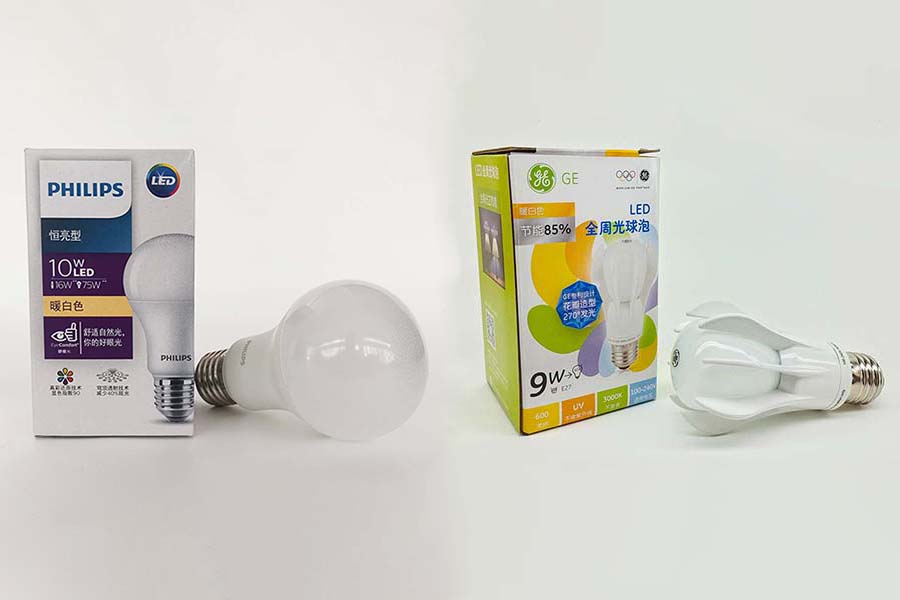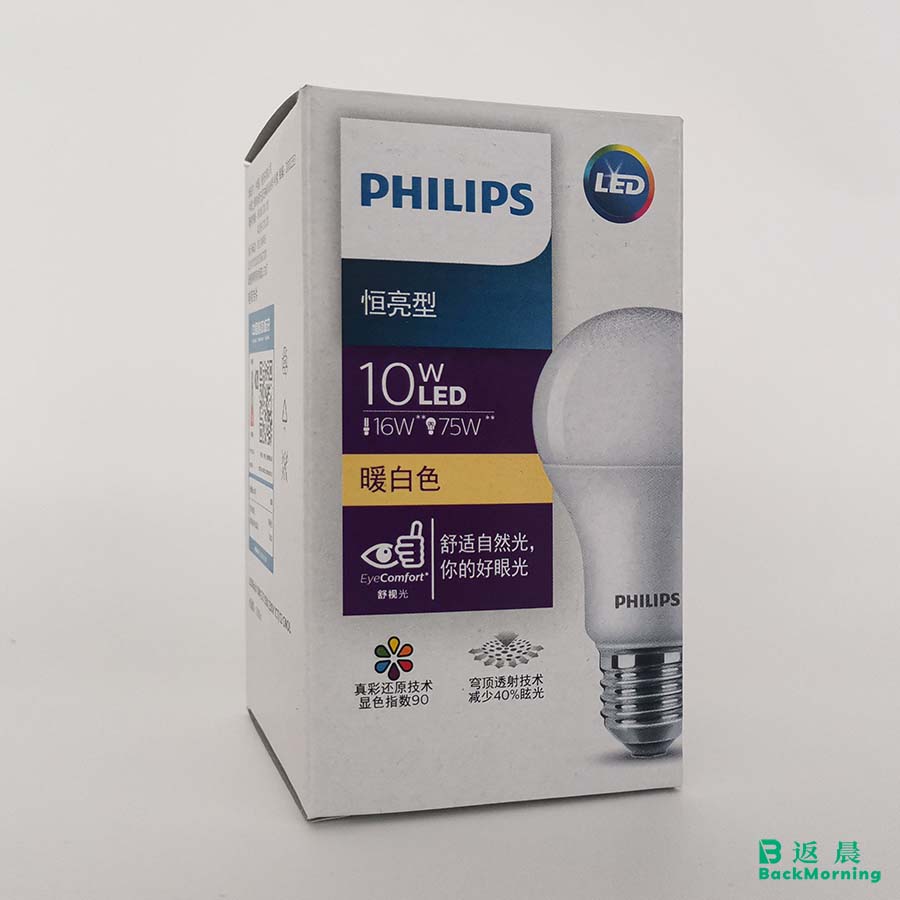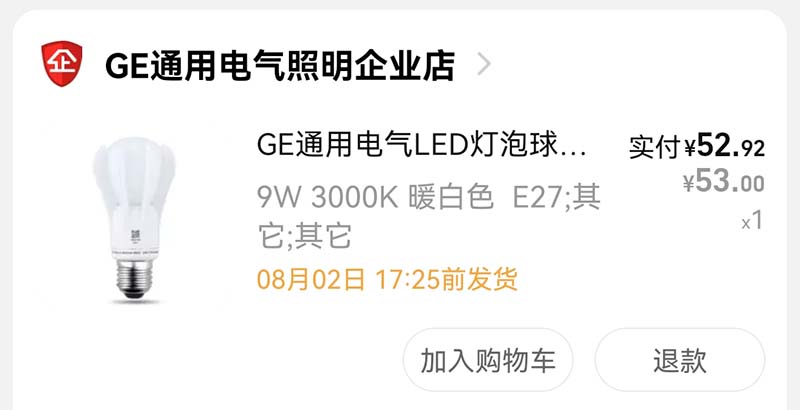Perhaps you are looking for LED light bulbs or manufacturers of similar LED lights.
There are many brands available in the market.
You can find various manufacturers in China and other countries and regions.
And perhaps you are a lighting solution provider.
Or an interior designer who will need light bulbs for the projects.
- What should you look for when choosing light bulbs?
- Can you use different brands interchangeably?
Meanwhile, is picking light bulbs with good quality as simple as buying from brands?
Don’t need to search, just believe the famous brands?
Do brands always live up to what they promise on the packages?
It’s normal if you have these questions.
It’s really not that simple to recognize the quality of various LED lights.
Recently, we’ve got LED light bulb samples of two of the top lighting brands.
- One is Philips’ 10W LED light bulb.
- The other is GE’s 9W LED lights blub.
Below is some basic information about the samples.
Sample 1: Philips EyeComfort
- Specifications: 10W, 3,000K, 1,000lm, 220-240Vac
- Retail price: CNY 68.00 for a pack of 4 (Approximately USD 10.06).
- That means, CNY 17.00 for 1 bulb (Approximately USD 2.51).
Sample 2: GE
- Specifications: 9W, 3,000K, 600lm, 100-240Vac
- Retail price: CNY 53.00 (Approximately USD 7.84)
Please note that the prices can be different in various countries and regions.
The GE sample we get for our tests is in mainland China.
- Probably you know that GE has quit the market of mainland China.
- The retail price of the GE sample looks dramatically higher.
- Most likely it’s because the light is imported from another country.
- To be fair, we don’t compare the prices here.
Why compare LED bulbs of 10W and 9W?
Wattage is an essential indicator that helps with evaluating LED lights.
But one sample is 10W and the other one is 9W.
- You may wonder: are they comparable?
Probably you may not know.
- The values of parameters – shown on sales packages – usually are not the same as their actual values.
- It’s the same as what a manufacturer claims may not be the same as their actual performance.
- That’s why we work as a third-party quality inspection company to reveal the truth.
It’s the same logic for picking the right brands and the right models.
And also working with the right manufacturers.
Don’t make decisions solely based on those rated values on sales packages or specification sheets.
1. First thing to consider before you buy
Essentially, LED light bulbs are a kind of light source.
You buy them because you want to illuminate your spaces.
- Therefore, we can say the brightness of a light bulb is the most important thing to consider.
- As a regular user, you can read the parameters on the sales package for a quick decision.
- Usually, check the value for Lumen on a light’s sales package.
 Philips
Philips
|
 GE
GE
|
|
|---|---|---|
| Wattage | 10W | 9W |
| Lumen | 1,000LM | 600LM |
| Color Temperature | 3,000K | 3,000K |
| Sales Price | CNY17.00 / USD2.51 | CNY53.00 / USD7.84 |
Here we can see:
- The Philips’ light bulb claims to produce 1,000lm
- And the GE light bulb claims to produce 600lm
The Philip light bulb is a better pick regarding brightness.
This conclusion is based on the values they claim themselves.
However, the quality of light that a bulb produces is not as easy as turning it on and off.
- We can see some misunderstandings from time to time.
- Turn the light bulb on and conclude it’s good as long it’s as bright as you desire.
- Compare two light bulbs and believe the one that looks brighter is better.
The quality of light is sophisticated and a combination of several critical parameters.
- They need some professional instruments to obtain some critical parameters regarding their quality.
- That’s why we have to rely on professional instruments to obtain data for analysis.
2. First impression on overall design
Both samples feel a kind of weight in your hands.
Not the feeling of cheap and light plastics.
- Particularly, both have a housing/body made of aluminum.
- This is an ideal material for optimum heat dissipation.
- And good heat dissipation is a critical factor for assuring the life spans of LED lights.
Another thing to mention is the GE sample has some patterns like flowers for its housing.
- On the one hand, it can work as some kind of visual design that differentiates itself.
- On the other hand, guess it’s more or less good for reducing glare.
Simply put, both samples use good materials and have a solid design.
3. Spectrum test results
Naked human eyes are not as reliable as you may imagine.
Therefore, we can’t judge the quality of LED lights by simply looking at them.
Here, we do spectrum tests with our integrating sphere to obtain 6 critical parameters.
They are more accurate and reliable for verifying the quality of light that different bulbs produce.
- Usually, the performance of electronic materials and components changes after working for a while.
- Theoretically, the point after they work for 30 minutes is considered to be a preferable result for comparison.
Therefore, the tested values that here are all after the samples are lighted for 30 minutes.
 Philips
Philips
|
 GE
GE
|
|
|---|---|---|
| Total Lumen | 1,094.9LMS | 714.9LMS |
| LM/W | 115.3 | 81.2 |
| RA | 93.6 | 81.9 |
| SDCM | 1.8 | 4.8 |
| CCT | 2,893K | 3,049 |
| Wattage | 9.49W | 8.8W |
1). Total Lumen
Total Lumen is an indicator for measuring the brightness of a light bulb.
The higher the number of Lumens, the brighter the light bulb is.
Here we can see that the samples produce:
- Philips: 1,094.9 Lumens at 30 minutes, about 9.5% more than its rated value 1,000 Lumens.
- GE: 714.9 Lumens at 30 minutes, about 19.2% more than its rated value 600 Lumens.
As mentioned above, the sole purpose of LED light bulbs is illumination.
- Generally speaking, it is preferable to pick the bulb with a bigger Total Lumen value.
- That means your money receives more light.
- From this point of view, we can say Philips is a better choice.
However, we don’t oversimplify that a bulb with a bigger Total Lumen is always better.
- You will also need to consider your lighting designs and applications.
- Don’t choose a bulb if it is too bright for your lighting target.
- Choose the one that best fits your real application.
2). LM/W
Another important factor to consider is the efficiency in turning electricity into light.
It is a measurement of how much light a bulb produces per wattage (Lumen/Wattage).
- A bigger number of LM/W is more favorable than a smaller number.
- You want to choose a more energy-efficient light bulb.
A higher LM/W value is good for saving home energy consumption.
And the saving will be even more dramatic if the applications are for larger buildings.
- For example, offices, and shopping malls, where many light bulbs may be installed.
Philips indicates a rated value of 100 for its LM/W on the sales package.
- And the value is 115.3 at 30 minutes.
GE has not indicated a rate value for LM/W on the sample’s package.
But we can get a theoretical value by a simple math:
- “Rated Lumen / Rated Wattage” = 600Lumens / 9W = 66.7
- And its tested value is 81.2 at 30 minutes
- Obviously, the Philips light bulb has dramatically better energy efficiency.
- It’s overwhelmingly higher than the GE bulb sample.
3). Ra
The parameter Ra tells you how well a light bulb can make colors look accurate and vivid.
A bigger value of the color rendering index means better quality of the LED light.
- Some applications demand lights with good color rendering performance.
- A minimum Ra value of 90 is preferable for demanding applications.
- Such examples include fashion stores, museums, etc.
This Philips light bulb indicates a rated value of 90 for its Ra.
- And the tested value is 93.6, measured at 30 minutes.
GE has not indicated a value for its Ra on the sample package.
- So, we just consider the tested value of 81.9, measured at 30 minutes.
Philips indicates a value of 90 for its Ra, and the tested value is 93.6.
- This is a great performance and can be for some demanding applications.
GE has a tested value of 81.9.
- This is just an average value that’s among many samples that we’ve tested.
Better to pick a light that indicates a color rendering index on its sales package.
- Either Ra or CRI will be fine, as long as there is an indicator.
- This is important if seeing accurate colors is important for you.
4). SDCM
You can take SDCM as color uniformity.
Theoretically, the lower the number of SDCM, the more uniform LED light bulbs are.
- If you are going to install more than one light bulb together, consider bulbs with smaller SDCM values.
- Make sure the LED light bulbs has an actual SDCM value smaller than 6.
Neither Philips nor GE has indicated a value for the SDCM parameter on the bulbs’ packages.
We have to rely on the integrating sphere for this result.
If you are going to install many blubs, better to get this data from your suppliers.
In case, unfortunately, you see the lights look different after installation, you know what goes wrong.
If you are going to work with a bulb manufacturer, then make sure to do test and get real SDCM values.
- The Philips light bulb has an SDCM value of 1.8, measured at 30 minutes.
- GE has a tested SDCM value of 4.8, measured at 30 minutes.
- Be careful: a smaller SDCM value means smaller difference
- The Philips sample has better performance regarding color uniformity.
- But GE is still good, since it’s below the standard maximum value of 6.
5). CCT
Color temperatures are important for creating different feelings – like warm or cool.
And we use the parameter CCT (Correlated Color Temperature) for evaluation.
The CCT values of most LED lights are usually within 2,700 K to 6,500 K.
Both the samples of Philips and GE have the same CCT value 3,000K.
- And the tested value for Philips sample at 30 minutes is 2,893K
- And the tested value for GE sample at 30 minutes is 3,049K
Both of them have accurate color temperatures.
- You won’t make mistakes by picking either one if you need a 3,000K bulb.
6). Wattage
Wattage indicates how much electricity that light bulb uses.
- It is an essential parameter that lays the foundation for how bright a light bulb can be.
- For this reason, we still need to pay attention to its value when evaluating LED lights.
The rated value for this Philips light bulb is 10W.
- While the tested value is 9.49W, measured at 30 minutes
The rated value for this GE sample is 9W.
- While the tested value is 8.8W, measured at 30 minutes
Both of these 2 results are within the standard tolerance.
- The actual difference is 0.69W, not as big as their rated difference 1W.
- The difference in parameters may not be as big as they appear to be.
Conclusion
Both samples we’ve tested are the top lighting brands.
However, the tested values for some of the critical parameters are quite different.
Below is a table that summarizes what we’ve compared.
 Philips
Philips
|
 GE
GE
|
|
|---|---|---|
| Total Lumen | ||
| LM/W | ||
| RA | ||
| SDCM | ||
| CCT | ||
| Wattage |
- Generally speaking, the Philips light bulb is preferable to the GE one.
- It has better performance regarding 4 of the 6 critical parameters that we’ve tested.
Last but not least, BackMorning is a third-party quality inspection company.
Our job is to reveal the truth about the quality of various LED lights.
If you may need help with assuring the quality of your LED lights or manufacturers, drop us a line.
Usually, we reply to most emails in just a few hours.
Thanks for reading!
Related posts:
 9 Practical Buying Tips for LED Streetlights
9 Practical Buying Tips for LED Streetlights
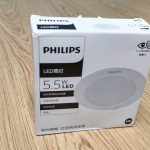 Spectrum Test for Philips LED Downlight DN190B 5.5W
Spectrum Test for Philips LED Downlight DN190B 5.5W
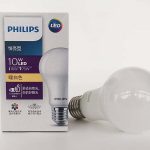 LED Light Bulb Quality – Review on Philips E27 10w BPZ1000-930E27
LED Light Bulb Quality – Review on Philips E27 10w BPZ1000-930E27
 Test and Show High Quality Streetlight T12A-2 – Shape and Structure
Test and Show High Quality Streetlight T12A-2 – Shape and Structure
 Misunderstanding When Sourcing Backlite Panel Lights
Misunderstanding When Sourcing Backlite Panel Lights
 LED Strip Lights’ Quality, how to test in a professional way?
LED Strip Lights’ Quality, how to test in a professional way?

